
Recent Blog Posts
May 3, 2011
Are Leg Extensions a Viable Exercise?
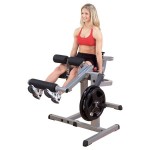
I recently did an interview with my friend and colleague, Nick Tumminello about the pros and cons of the leg extension. On several Facebook pages, the article ruffled the feathers of some who maintain that leg extensions are completely non-functional, dangerous, and an all-around useless exercise. The discussion was interesting, to say the least, and stimulated lots of good info.
Check out the article at Are Leg Extensions Good or Bad, Safe or Dangerous, Effective or a Waste of time, Functional or NonFunctional? – Exercise Expert Brad Schoenfeld has the Surprising Answers! and let me know your thoughts.
Stay Fit!
Brad
April 12, 2011
Fasted Cardio Article
I’ve agreed to be a regular contributor to bodybuilding.com–the Internet’s largest bodybuilding site. My first article for the site critically analyzes the strategy to perform cardio on an empty stomach. It’s a less technical version of the research review I did for the NSCA Strength and Conditioning Journal. You can read the article at the link below:
The Myth of Cardio Before Breakfast–Debunked!
I’ll keep you posted on future articles…
Stay Fit!
Brad
March 31, 2011
Targeting the Calf Muscles
Walk into any gym and you’ll see people performing calf raises with their feet turned and tilted in various directions. For years, bodybuilders and other fitness athletes have claimed that this strategy works different aspects of the calf muscles, thereby promoting greater muscular development. Unfortunately, research had never sufficiently investigated the validity of these claims. Until now…
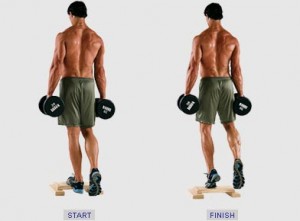
A recent study appearing in the Journal of Strength and Conditioning Research evaluated the muscle activity of the gastrocnemius (the diamond-shaped muscle that is most prominent when you flex the calves) when performing a calf raise with feet in one of three positions: internally rotated (i.e. toes pointed inward), externally rotated (i.e. toes pointed outward) or neutral (i.e. toes straight ahead). EMG was used to determine muscle activity. The results? The lateral head of the gastroc (i.e. the outer aspect of the muscle) showed the greatest muscle activity when the feet were internally rotated while activity of the medial head (i.e. the inner aspect of the muscle) was maximized with the feet externally rotated.
The take-home message here is that you can in fact selectively target the individual heads of the gastroc (lateral vs. medial) by altering your foot position. Now from a practical standpoint, this really doesn’t mean much unless you have an imbalance between the two heads. A neutral foot position provides approximately equal stimulation of both heads, so keeping your toes pointed straight ahead will promote overall calf development. But if you want to bring up one aspect of the gastroc as opposed to the other (usually the lateral head is underdeveloped since its only about half the size of the medial head), turning your toes either in or out will help to improve muscular symmetry. As always, understanding the science will help you achieve your fitness goals.
Stay Fit!
Brad
March 14, 2011
Barbell Hip Thrust for a Better Butt
Want an excellent exercise to target the gluteus maximus? Consider incorporating the barbell hip thrust into your routine. The exercise was first brought to my attention by uber-trainer Bret Contreras. The benefit? As opposed to squats and other exercises, it works the glutes and other hip muscles from a horizontal vector as well as increasing muscular tension throughout the complete range of motion of the movement. Bottom line: improved glute development and potentially greater muscular power.
Here is a demonstration of the exercise as performed by Bret. If you want a better butt, give the move a try–you won’t be disappointed.
embedded by Embedded Video
February 19, 2011
Spot Reduction Silliness
I must get at least a half-dozen emails a day asking some sort of variation of the following question: “What exercise can I do to reduce the fat in my (fill in the blank with a problem area).” No matter how the question is phrased, my answer is always the same: sorry, but there is no such exercise…
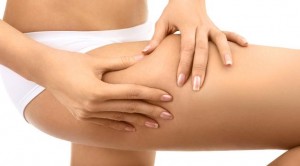
I’ve said it over and over in my books and magazine articles and I’ll say it again here: you can’t spot reduce fat. It’s a physiologic impossibility. All the sit-ups in the world won’t give you a flat stomach; no amount of leg raises will preferentially slim down your saddle bags. In reality, trying to zap away your problem areas is literally an exercise in futility.
Here’s why spot reduction doesn’t work. When calories are consumed in abundance, your body converts the excess nutrients into fat-based compounds called triglycerides, which are then stored in cells called adipocytes (a.k.a. fat cells). Adipocytes are pliable storehouses that either shrink or expand to accommodate fatty deposits. They are present in virtually every part of the body including your face, neck, and soles of your feet.
When you exercise, triglycerides in adipocytes are broken back down into fatty acids, which are then transported via the blood to be used in target tissues for energy (note: fat cells and muscle have separate blood supplies). Because fatty acids must travel through the circulatory system—a time-consuming event—it is just as efficient for your body to utilize fat from one area as it is another. (Side note: muscles do contain their own internal fat stores called intramuscular triglycerides that can be used directly by the muscle for fuel, but these stores have no impact on your appearance.) Bottom line: the proximity of adipocytes to the working muscles is completely irrelevant from an energy standpoint. Simple, right? Well, perhaps not…
Several years ago, a research group from Copenhagen, Demark came out with a study that seemingly challenged common wisdom about spot reduction (1). In short, the study showed that fat breakdown was greater in fat depots adjacent to working muscles compared to distant muscles. This led the researchers to conclude that “specific exercises can induce ‘spot lipolysis’ in adipose tissue.”
Say what? After that extended physiology lesson, does this actually mean that spot reduction is a reality? In a word: No! Lipolysis (i.e. breakdown) does not necessarily equate to oxidation (i.e. fat burning). As noted, the fatty acids mobilized from adipocytes adjacent to working muscles aren’t just morphed into the muscle for use as fuel. They would still have to travel through the circulatory system to reach their intended destination, which may or may not occur. If not, the fatty acids would simply be repackaged into triglycerides and stored back in adipocytes. Bottom line: the study did not in any way show spot reduction; it simply showed a very slight increase in mobilization from the underlying muscle, which means next to nothing in the overall scheme of losing body fat.
Mark Young, a very astute fitness pro, did an excellent job analyzing the shortcomings of this study in his blog post, Spot Reduction is Real?. Check it out and you’ll see how research can be misconstrued if you simply look at the overall findings of a study and don’t delve into the particulars.
Stay Fit!
Brad
1) Stallknecht B, et al. Are blood flow and lipolysis in subcutaneous adipose tissue influenced by contractions in adjacent muscles in humans? American Journal of Physiology. Endocrinology and Metabolism. 2007 Feb;292(2):E394-9.
January 18, 2011
How Much Do Genetics Contribute to Muscle Development?
For those who’ve read my books and/or articles on fitness, you’ll know I constantly preach the fact that you can’t escape genetics. Specifically, you can’t get “Platz’s thighs” or “Schwargenneger’s biceps” unless you happened to be born to said parents. Genetics are unique to the individual. Your fitness goal therefore should be to optimize your own God-given attributes. Everyone can have a terrific physique within their own genetic framework provided they’re willing to work for it.
My friend and colleague Bret Contreras wrote an excellent article on the topic of genetics in bodybuilding. Bret reviews the research on the subject, and explains how genetics affect results. It’s a very insightful read that pulls no punches. Here is a link to the article:
The Truth About Bodybuilding Genetics
Stay Fit!
Brad
January 12, 2011
Take two NSAIDs after a workout…Not!
Feeling sore after a workout? What do you do? Perhaps pop a couple of Advil, Motrin, Aleve, or some other brand of non-steroid anti-inflammatory drug (NSAID) and wait for the discomfort to subside? If so, you might want to reconsider. Here’s why…
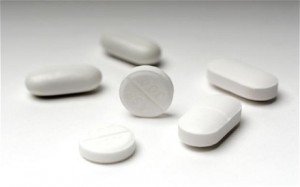
These drugs work by blocking an enzyme called cyclooxygenase (COX). COX catalyzes the production of various prostanoids that play a role in inflammation and algesia. Theoretically, reducing prostanoids should help to alleviate localized muscle muscular pain.
Most research, however, fails to support the efficacy of NSAIDs in reducing muscle soreness. For instance, creatine kinase levels (a marker of muscle damage) have not been shown to be significantly different between those taking NSAIDs and a placebo group, indicating that NSAIDs have little effect on attenuating the root cause of pain. Moreover, the majority of studies show no differences in self-described pain ratings associated with muscle soreness after taking NSAIDs. This is particularly true in severe cases of muscle soreness, which is when a pain reliever would be of greatest value.
While a lack of effectiveness in reducing post-workout pain is certainly reason enough to avoid NSAIDs, there is a larger issue here for those who are serious exercisers. Namely, prostaglandins are known to regulate protein metabolism. Specifically, they help to stimulate protein synthesis, which is the mechanism by which muscles repair themselves and grow stronger. Studies have shown that post-exercise protein synthesis is virtually non-existent following consumption of NSAIDs. And if your muscles don’t synthesize protein after a workout, you won’t see any appreciable improvements in muscle development.
If that wasn’t enough, there is emerging evidence that NSAIDs may impair satellite cell activity. Satellite cells are muscle stem cells that have a number of functions in promoting muscle development. When activated by exercise, they multiply in number, become more specialized, and then fuse to existing muscle fibers to provide the precursor materials needed for repair and subsequent growth of new muscle tissue. Perhaps more importantly, they donate their nuclei to the stimulated muscle fibers so that protein synthesis can be increased to support growth.
Bottom line: Try to steer clear of NSAIDs whenever possible. Understand that the inflammatory response following an intense training session is part of the healing process that is necessary to develop your muscles. Shortchange healing and you shortchange muscular development.
So what to do about the pain from soreness? The best advice is to stay active—don’t just lie in bed or sit around at your desk all day. An active recovery will help to maintain blood flow to the affected muscles, which will aid in healing. There is some evidence that massage can help to restore muscle function and reduce achiness. It’s certainly worth a try. If nothing else, it can provide temporary relief by taking your mind off the pain.
Stay Fit!
Brad
December 28, 2010
Stay Away from the Pink Dumbbells!
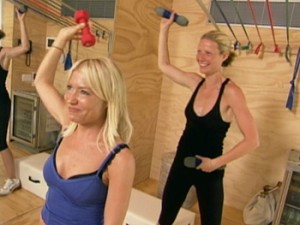
A colleague forwarded me the following link to a video of Gwyneth Paltrow’s Workout. Ordinarily I would just get a laugh at the horrendous form being used and dismiss it as simply another clueless trainer in a largely unregulated industry. However, Gwyeth’s trainer, a woman named Tracy Anderson, goes on to make perhaps the most asinine statement ever uttered by a so-called fitness professional. “We use three pound weights and only three pound weights,” Tracy exclaims. “No woman should ever lift more than three pound weights!”
Huh???
I spend the better part of my life preaching to women about the importance of hitting the weights hard and dispelling the myth that they will get “bulky” from doing so, and some “celebrity” trainer–a person that Gwyneth Paltrow calls the “exercise genius of all time!”–tells them they’re going to turn into a she-male if they lift anything heavier than a a pink dumbbell. Please!!!

With all due respect, Gwyneth Paltrow doesn’t even look like she works out. Sure, she’s thin. But chalk that up to genetics and diet. Body-wise, she has no noticeable muscle tone (not surprising given that she doesn’t lift anything heavier than three pounds!), and not much shape, either. That despite claiming to train two hours a day, six days a week! I’d say that’s a pretty poor return on investment. Look at the two photos posted here. Compare Gwyneth’s physique to a fitness or figure competitor and you tell me who has a better body.
Ladies, don’t be fooled. The only way to develop a fit, strong body is to challenge your muscles beyond their present capacity. This is called the overload principle, and it’s a central tenet of exercise. If you don’t progressively overload your muscles, they won’t develop and you won’t have muscle tone! Moreover, adding a few pounds of muscle to your body won’t make you look big or bulky. Rather, it will give you pleasing shape and definition. It will prevent areas from sagging with age. It will make you strong and give you better posture. And it will help to keep you lean (read: less body fat). Bottom line: Ditch the pink dumbbells and don’t be afraid to lift real weights!
Stay Fit!
Brad
December 21, 2010
Cooper Institute Weighs in on Squatting Biomechanics
In a blog post titled, What’s Your Squat IQ?, the Cooper Institute did a solid job providing practical applications for squatting based on my recent review article appearing in the Journal of Strength and Conditioning Research. However, one issue I have with the article was the recommendation that “if you can’t see your toes” when squatting then “you need to sit back more.” The general idea behind the advice is sound. Certainly you should try to minimize forward translation of your knees as much as possible to decrease forces acting on the knee. But this should not be done at the expense of greater forward lean, which significantly increases stresses on the lower back region–an area that is highly susceptible to injury. Moreover, the belief that you’ll somehow damage your knees as soon as they go past your toes during the squat is not supported by research. Ultimately body type will dictate squatting kinematics and some people simply will not be able to maintain a position where the knees stay behind the plane of the toes. Provided you do not have existing knee pathology, you shouldn’t worry about this as the detrimental effects of knees-over-toes during the squat are overstated.
Stay Fit!
Brad
December 9, 2010
About.com Article on Muscle Building
Check out the article The Latest on Muscle Building Research for a simplified summary of my recently published research review paper, The Mechanisms of Muscle Hypertrophy and Their Application to Resistance Training. Paul Rogers, the weight training expert at About.com, did a nice job covering the basics on the subject.
Stay Fit!
Brad





 Entries (RSS)
Entries (RSS)



